Nissan Europe has benefited from closer collaboration between engineers, suppliers and logistics during vehicle development, especially for its Sunderland plant
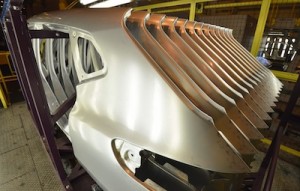
The symbol for much of this success has been the British brand (but Tata Motors-owned) Jaguar Land Rover, which has doubled sales and production since the downturn, built an engine plant in the UK and a full manufacturing plant in China.
However, Britain’s biggest car factory is Nissan’s in Sunderland, in the English northeast. It is the first in the country’s history to assemble 500,000 cars in a year, which it did in 2012 (512,000) and last year (501,000) – more vehicles than JLR’s three UK plants combined. Nissan is also Britain’s largest vehicle exporter, shipping 400,000 units per year to around 130 markets.
The carmaker has poured investment into Sunderland. The small drop in production last year was mainly the result of planned stoppages to prepare for three launches inside ten months: the European-version of the electric Leaf last April, the Note in September, followed in January by the next generation Qashqai, the plant’s flagship vehicle.
Sunderland is now preparing to become the first European plant to build Nissan’s premium Infiniti brand, when the Q30 rolls off the production line later this year. According to Kevin Fitzpatrick, vice-president of UK manufacturing, the plant could approach its 550,000-unit annual capacity after Infiniti ramps up in 2015.
Macroeconomics, productivity and logistics
Nissan’s success has been buoyed by favourable macroeconomics and a well-honed manufacturing operation. Britain’s relatively loose labour laws keep the plant flexible (according to Fitzpatrick, 30% of the plant’s 7,300 employees are on temporary contracts). Cheap credit in the UK, meanwhile, has helped domestic sales recover. A weak pound has been good for exports, supported further by open trade in the European Union; despite the weak economy, around 60% of Qashqai exports head to the EU (a reason why Nissan executives have warned the UK against toying with EU exit).
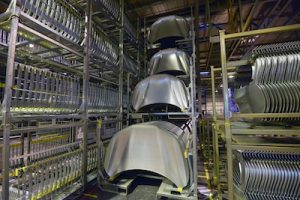
Logistics and supply chain management strategies are also vital to the plant’s competitiveness. According to Nissan Europe’s purchasing and manufacturing boss, logistics costs now often exceed those of manufacturing, which has led Nissan to study the supply chain more deeply during a vehicle’s engineering phase.
“We are very focused on optimising logistics costs,” says Colin Lawther, senior vice-president for manufacturing, purchasing and supply chain management. “Typically now, 20% of the cost of making a car is in logistics, which is actually bigger than the manufacturing cost within the plant. We have a strong eye on these costs.”
The carmaker’s supply chain executives, along with the Renault Nissan Alliance Logistics Europe team that manages inbound and outbound transport, have engineered logistics flows and increased pack density for standard packaging. From a transport point of view, trucking fill rates are very high on a global Alliance scale for both local supplies and global material (which arrive through the nearby port of Tyne) into nearby warehouses to the plant, where they are deconsolidated and sequenced to the line every hour.
Another focus has been in materials handling and parts flow. The Sunderland plant is characterised by a large amount of just-in-time and just-in-sequence delivery. As with a number of other Nissan factories globally, including in the US, several suppliers manufacture on site. For example, a supplier builds dashboard modules in one hall after receiving Nissan broadcasts only hours before the modules are due at the line; once assembled, automated guided vehicles carry them to the trim and chassis line in sequence, where they are fitted to vehicles in three seconds.
The plant is currently preparing for another evolution in its material flow, however. According to Heath Holtz, vice-president of supply chain management for Nissan Europe, higher product complexity and variation, especially with the new Qashqai and Infiniti, require more kitting operations.
“We are moving towards kitting and away from sequencing parts directly to the line to reduce the handling and preparation activities it requires,” he says. “However, we will still continue to do a lot of sequencing into the module and kitting areas.”
Supply chain development and integration
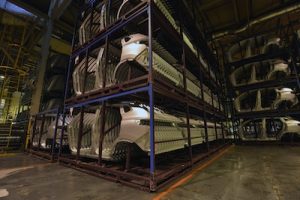 Nissan engineers are taking more consideration for packaging and parts flow in the development phase
Nissan engineers are taking more consideration for packaging and parts flow in the development phaseAccording to executives, the link between product development, engineering and supply chain planning has been important in the growth of Nissan’s European operations – which include plants in Barcelona and St Petersburg, as well as shared production with Renault in various places – and especially for Sunderland.
While Nissan’s European headquarters is in Switzerland, there are 700 employees carrying out ‘head office’ functions in Sunderland, including in supply chain, purchasing and logistics. The company also has a London-based design team and an engineering and technical centre in Cranfield, north of London. The Qashqai was designed and engineered completely in the UK, with the Sunderland plant the basis for much testing and development. The UK-based teams have also worked on the Q30.
This proximity between production and development has helped improve the plant’s logistics and supplier development, according to Lawther. One particular area has been in packaging design and standards.
“Once we’ve identified the logistics chain, the most important part for us is to design the logistics packaging so that we have maximum density,” he says. “We have a logistics engineering team that works with CAD design data to create standard packs optimised for nesting, protection and loading.”
Lawther adds that Cubic utilisation is a global KPI within all Nissan and Renault plants, and Sunderland is judged on how many cubic parts fit into a standard container for its models. “It’s a virtuous competition, because if you are at the top of that league table, it means that your manufacturing environment is receiving the lowest costs,” he says.
Alec Patterson, senior engineer for project management at the Nissan Europe Technical Centre in Cranfield, says that in the past four years Nissan has moved strongly towards a “total delivery cost” approach for sourcing and manufacturing, rather than chasing material piece prices. That is particularly well reflected in the new Qashqai, in which engineers considered not only pack density during the development phase but also how to reduce picking errors.
"In the engineering phase, we tried to reduce complexity and the reliance on sequencing, as it is expensive and complex to sequence parts"
- Alec Patterson, Nissan Europe Technical Centre
“We have worked together with designers and tier suppliers, trying to reduce complexity and the potential for errors,” he says. “For long distance suppliers, we have worked on reducing weight and improving packaging recycling.”
This integration in development can also be seen in Nissan’s consideration of the material parts flow to its warehouses and factories, and the shift towards more kitting, especially for Infiniti. “In the engineering phase, we tried to reduce complexity and the reliance on sequencing, as it is expensive and complex to sequence parts,” says Alec Patterson.
Up to now, Fitzpatrick says that kitting levels for trim and chassis at Sunderland are below Nissan levels globally. “We did that deliberately, because at some point you reach breakeven from a productivity point of view and then kitting just becomes a dogma,” he says.
But the higher complexity of parts is changing that. The new Qashqai has around 17,000 variations, according to Fitzpatrick, increasing the part numbers needed at the line. For the Q30 production, the variation is so high that without a move towards kitting, Nissan would need a trim and chassis line about a mile long, he says.
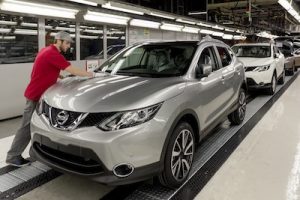
Nissan is extending the body shop and the trim and chassis area for line two, where Infiniti is to be built, but more kitting will help it avoid having to further extend the line or add warehouse space.
“We want to de-spec our inbound logistics, because the sequencing operations and preparation activities in the warehouse are very expensive,” says Fitzpatrick.

Such integration with logistics and materials handling highlights the potential advantages – besides lower transport and inventory costs – of having a locally developed supply base with which to coordinate. Patterson admits, for example, that tier suppliers do more engineering work on packaging since it is their direct product, but the close coordination and communication with Nissan is essential.
Fitzpatrick says that during the pre-launch phase for the new models at Sunderland, Nissan has worked intensely on “supplier enforcement” in areas like delivery, especially with local suppliers.
“There is a very intense activity with suppliers, particularly in the six months leading up to launch, where we visit with suppliers and monitor their launch plans, looking for weaknesses and making changes,” he says. “We have quite an in-depth activity with local suppliers for things like delivery statement and just-in-time logistics.”
Patterson also says that he and his fellow engineers at the technical centre work with local suppliers on managing change in the supply base, including updates to products and avoiding parts obsolescence.
Global (content) matters
Localisation of the supply base remains a major topic for Nissan and the wider UK automotive industry. The UK Automotive Council, a government and private industry partnership (of which Fitzpatrick is a member), estimates that OEMs in the country currently source around 35% of material in the UK, compared to rates nearly double that in Germany. The council estimates that carmakers could source as much as 80% of material in the UK.
Start of production – 1986
Total investment – £3.5 billion ($5.8 billion)
2013 production – 501,000 units
Annual capacity – 550,000 units
Cars made per hour – 113 (12.5 in 1986)
Employees – 7,314 (30% temporary)
Models – Qashqai, Juke, Note, Leaf (Infiniti Q30 by 2015)
A close look at the supply chain for Sunderland reveals the complexities (and even contradictions) of its supplier network and sourcing trends. Nissan’s scale in Sunderland means that it has already been able to integrate many components at or close to the factory, including having its own casting plant for cylinder heads, a unit shop for petrol engine assembly, an axle plant for suspensions and a lithium-ion battery plant for Leaf production. Eight suppliers produce at the plant including for dashboard modules, seats, headliners and fuel cluster pipes.
A number of suppliers are also located in the Sunderland region just a short drive away, including Valeo, Tacle, Calsonic Kansei, Hashimoto and Unipres. Lawther says that about 80% of the cubic volume of parts for Qashqai is manufactured in the UK.
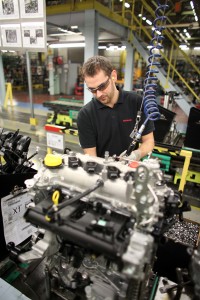
However, the volume in weight is not equal to part numbers or value. For example, 58 of the 225 suppliers for Qashqai are in Britain, with the rest coming from more than 20 countries – and mostly from Europe.
Many internationally sourced materials are high value, low cubic volume parts like engine control modules or APS activators, says Lawther. “We rely on one plant in central Europe, for example, that builds a very high volume of parts, but they are very cubically dense, so they minimise logistics costs,” he says.
However, Nissan also imports major equipment, including diesel engines from France and automatic transmissions from Japan. For the Nissan Leaf, executives last year told Automotive Logistics that although Nissan has localised electric battery production in Sunderland, it still imports the battery’s electrode from Japan. UK content for the Leaf at the start of production was about 34%, part of 90% coming from wider Europe.
The result of these interchanges is that the Sunderland plant receives many knockdown parts from around the world, including India, China, Japan and North America. Likewise, it also sends parts to these locations, as well as to Russia, which will eventually build the Qashqai and X-Trail, a related model. While executives admit they are pushing to increase local sourcing in the UK, the Sunderland plant is at the centre of an important evolution in Nissan’s production strategy that requires, almost by definition, a global supply chain. The plant produces models on four distinct platforms, which will rise to five next year with Infiniti. According to Holtz, the connections between the supply bases have grown across Nissan and Alliance manufacturing locations, leading to more parts sharing between regions, even as other components are localised in multiple locations.
Part numbers: 2,708
Part locations: 75% from Europe,
25% ROW
Local suppliers: 58 from UK,
166 from Europe
Sales markets: 59% Europe, 14% UK,
12% Russia, 15% ROW
The new Qashqai, for example, is built on the Alliance ‘Common Module Family’ system, an architecture that supports multiple platforms and model ranges, and is expected to eventually include 1.6m vehicles and 14 models across Renault and Nissan. Qashqai shares parts with models like the Nissan X-trail, built in Japan, and the Rogue, built in the US, as well as a number of Renault models.
The other models at the plant also share platforms globally, such as the Note on the ‘V’ platform (shared with Micra in India), the Juke on ‘B’ platform and Leaf on the ‘EV’ platform, which have related models built in Tennessee and Japan. There are other common points between Nissan Europe and other continents, such as the NV200 on the 'LCV' platform, which is built in Barcelona, Mexico and at other Nissan factories.
“There is also a large amount of cross-EU flows, including sharing with Renault and in Spain where we share suppliers between our plants in Sunderland and Barcelona,” Holtz says.

Even amid these global purchasing considerations, Fitzpatrick sees more growth potential for the UK supply chain. Along with Nissan’s expansion, other OEMs are investing in UK production, including JLR, Toyota, BMW, Honda and GM. The Society of Motor Manufacturers and Traders, the British automotive trade body, has predicted that UK light vehicle production could reach 2m units by 2017 from 1.5m last year. The British government has also been promoting a number of initiatives aimed at helping companies to invest in the supply chain.
“I see opportunities for a number of things, such as alloy wheels and tyres, much of which left the UK,” says Fitzpatrick. “With inflation and logistics costs rising in places like China and India, some companies are bringing this back.”
However, Fitzpatrick acknowledges that the competencies that left the UK supply chain over previous decades are slow to return, particularly with excess capacity in continental Europe.
“If you are a big European parts supplier, there are lots of opportunities in the UK, but also factories that are not full in mainland Europe, which would require complicated restructuring to close or downsize,” he says.
 The debate about a more ‘British supply chain’ has another context for Nissan. The Conservative party, currently in coalition with the Liberal Democrats, has promised a referendum on UK membership in the European Union by 2017 if the party wins an outright majority in 2015. With increasing euro-scepticism in the UK, there has been debate about the impacts a potential British pullout would have on the car industry.
The debate about a more ‘British supply chain’ has another context for Nissan. The Conservative party, currently in coalition with the Liberal Democrats, has promised a referendum on UK membership in the European Union by 2017 if the party wins an outright majority in 2015. With increasing euro-scepticism in the UK, there has been debate about the impacts a potential British pullout would have on the car industry.
Late last year, Renault Nissan chief executive Carlos Ghosn warned that, were there to be a change in the UK’s relationship with EU, the company would need to “reconsider our strategy and our investments” for the UK in the future.
With most British vehicle exports bound for the EU, and a large amount of inbound supply chains based there, analysts have said that an EU pullout would create tremendous uncertainty. However, Colin Lawther declines to get drawn into the controversy, and says the company is not wasting much time thinking about it.
“Nissan is very well embedded in Sunderland, and this plant is a very high performer,” he says. “Nissan would want to continue to work in an open-trade environment. If there were any change in ‘regime’ or regulations, we would fit out business around that.
“[UK exit from the EU] is really just speculation, and we’re not spending any management time on that. We don’t see it as an issue for today.”
Planning in advance
Regardless of the local or global shape of Nissan’s supply chain, the consideration for logistics and parts flow remains critical for optimising production and resources. Lawther gives credit to the company’s cross-functional approach, including supplier collaboration. He points to the use of ‘Upstream Function Task Teams’, which involve suppliers in the design of next generation parts even before business is awarded.
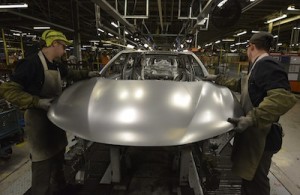
Deeper collaboration between Renault and Nissan is also likely in this area. While the companies have pooled inbound and logistics purchasing and transport for several years, the alliance recently pointed an ‘integration officer’ for manufacturing and logistics, which is expected to bring together the supply chain management and production control function between the two carmakers, which is still separate. Such ties should benefit Nissan’s supply chain as modular platforms bring it closer together with that of Renault.
Ultimately, Lawther says it’s important for supply chain planning to happen across the plant, engineering centre and supply base. Engineers design the parts to nest easily and reduce the packing density, for example, while manufacturing and supply chain examines what assembly should be done in-house or by suppliers.
“It must be a partnership event between design, manufacturing and logistics,” he says. And for Sunderland, that partnership appears to be strengthening.



































